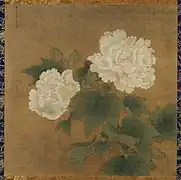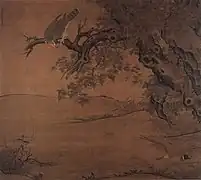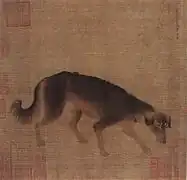
Li Di (Chinese: 李迪; pinyin: Lǐ Dí; Wade–Giles: Li Ti; c. 1100 – after 1197) was a Chinese imperial court painter during the Song Dynasty.[1] He was noted for painting flowers, birds, bamboo, and animals in motion.[2] Li was a member of the Academy of Worthies.[3]
Biography
Li was born in Heyang (河陽), in modern Meng County (孟县) in Henan Province. He worked at the Imperial Painting Academy, and his career spanned the reigns of emperors Xiaozong, Guangzong, and Ningzong.
The exact dates of his life are uncertain, only that his first signed painting is dated 1125, and his last known painting is dated 1197.
Family
Li Di's son, Li Demao, was also a painter in the Imperial Painting Academy.[4]
Gallery
 Red and White Cotton Roses (1197). Tokyo National Museum.
Red and White Cotton Roses (1197). Tokyo National Museum. White Cotton Roses (1197). Tokyo National Museum.
White Cotton Roses (1197). Tokyo National Museum. Maple, Falcon, and Golden Pheasant (1196). Palace Museum.
Maple, Falcon, and Golden Pheasant (1196). Palace Museum. Hunting Dog. Palace Museum.
Hunting Dog. Palace Museum. The Spring Tide Brings Rain. National Palace Museum.
The Spring Tide Brings Rain. National Palace Museum. Oxherds in Wind and Rain. National Palace Museum.
Oxherds in Wind and Rain. National Palace Museum.
Wikimedia Commons has media related to Li Di.
Notes
- ↑ Barnhart, p. 129.
- ↑ Cihai, p. 1262.
- ↑ Zhou, Mi (January 2002). Zhou Mi's Record of Clouds and Mist Passing Before One's Eyes: An Annotated Translation. Vol. 2. Brill. p. 165. ISBN 90-0412605-8. Retrieved 5 March 2013.
- ↑ Red and White Cotton Roses, Tokyo National Museum, Google Arts & Culture.
References
- Barnhart, R. M. et al. (1997). Three Thousand Years of Chinese Painting. New Haven, Yale University Press. ISBN 0-300-07013-6.
- Cihai Bianji Weiyuanhui (辞海编辑委员会) (1979). Cihai (辞海). Shanghai, Shanghai Lexicographical Publishing House.
This article is issued from Wikipedia. The text is licensed under Creative Commons - Attribution - Sharealike. Additional terms may apply for the media files.